Now this Victorian bogeyman has returned. Of the current sources one of the best sources for the story of Spring Heeled Jack is on Mike Dash website. A professional historian he has researched a lot of new information on this subject. He I believe is soon to produce a book based on his research.
I also have been looking into the subject for many years. This is since I found the story (at the time probably in one of the very few sources) as a child. This was in Elliott O’Donnell’s Haunted Britain. I have done much hunting for news clippings etc that at the present time of writing are new material. First however lets introduce you to the story of Spring Heeled Jack.
Spring Heeled Jack,
Spring-Heeled Jack, Springheel Jack, or Springald a figure in the popular imagination of the nineteenth and early twentieth centuries, is know for his ability to leap over high walls or across wide spaces, supposedly because of compressed springs in his boots.
Rumours about this figure swept through London and surrounding villages in the autumn and winter of 1837—8. On 8 January 1838, someone in Peckham anonymously warned the Lord Mayor of London that men of high rank had laid a bet with ‘a mischievous and foolhardy companion’, challenging him to:
Visit as many of the villages near London in different disguises — a ghost, a bear; in armour and as a devil; and, enter gardens for the purpose of alarming the inmates of the house. The wager has, however, been accepted, and the unmanly villain has succeeded in depriving seven ladies of their senses
The writer of the letter went on, “The affair has now been going on for some time, and, strange to say, the papers are silent on the subject. The writer has reason to believe that they have the whole history their finger ends, but, through interested motives, are induced to remain silent.”
The Times, 9 January 1838
According to the Morning Chronicle and the Morning Herald, the rumours had, begun in Barnes the previous September; some forty villages and suburbs had been gripped by panic. The attacker was generally described as ‘an unearthly warrior brass or steel armour, ‘with spring shoes and large claw gloves’, but occasionally white bear. Journalists tried to find witnesses, but failed:
A reporter visited many of the places above mentioned, where he found that, although the stories were everywhere, no person who had actually seen the ghost could be found. He was directed to many persons who were named as having been injured by this alleged ghost, but, on his speaking to them, they immediately denied all knowledge of it, but directed him to other persons whom they had heard had been ill-treated, but with them met with no better success; and the police declare that, although they have made very inquiry into the matter, they cannot find one individual hardy enough to assert a personal knowledge on the subject.
Morning Herald, 10 January 1838
As further complaints poured in, vigilantes and police patrols were set up and rewards offered, but nobody was caught. Journalists christened the villain ‘Spring Heeled Jack’; they viewed him as a human prankster, but many people described him as a demon.
The most famous case now came to light.
The fullest picture was given by a girl called Jane Alsop, who on 20th February opened the door of her home in Bearbinder Lane, Bow, to a man claiming be a police officer. He said they had captured Spring Heeled Jack in the lane. He asked her for a candle, when he had it, vomited blue and white flames and attacked her, tearing at her dress and hair with what felt like metallic claws. She told Lambeth magistrates that he was wearing a large helmet and a tight-fitting white costume like an oilskin; his eyes were like balls of fire. Two or three men were interrogated, but released without charge (The Times, 22 February, 2 and 3 March 1838). On 28 February, another young girl, Lucy Scales from Limehouse, was found in hysterics in the street, saying she had been pounced on by a tall, cloaked man who spurted blue flames at her (Morning Post, 7 March 1838). She had just been reading a press account of the attack on Jane Alsop. The London panic gradually died down, but others broke out in various towns over the next thirty or forty years, and were reported by various contributors to a correspondence in Notes and Queries in 1907. In Yarmouth in 1845, a delirious man wandering about in his nightshirt was mistaken for Spring-Heeled Jack and beaten up. In Peckham in 1872, there was alarm over a ghost leaping over walls and ditches, and vanishing with startling speed. In Sheffield in May 1873, rumours sprang up that a tall man in a sheet was scaring women for a bet; a mob searched the cemetery where he supposedly lurked, but found nobody, and clashed with the police. In 1877, at Aldershot barracks, two spectral figures ‘glowing with phosphorus’ and ‘making tremendous springs of ten or twelve yards at a time’ terrified the sentries. The last documented panics were at Liverpool in 1904 and in Bradford in 1926.
Spring-Heeled Jack entered fiction. In the 1840s, he figured in two plays (by J. T. Haines and by W. G. Wills) and an anonymous weekly ‘penny dreadful’; in all three, he is an evil character. But another penny dreadful in the 1870s, probably written by George A. Sala, radically reshaped the legend. Sala’s Jack, like today’s Batman or Superman, uses his power to defeat the wicked; he is a nobleman by birth, though cheated of his inheritance. He wears a skin tight crimson suit, with bat’s wings, a lion’s mane, horns, talons, massive cloven hoofs, and a sulphurous breath; he is immensely strong, and moves in gigantic leaps, thanks to his boots with their hidden springs.
Jack was not the first attacker in London
For about two months during the winter of 1803, the inhabitants of Hammersmith were much alarmed by reports of a malevolent ghost ‘stalking up and down the neighbourhood’. The affair led to a violent death, and was reported in the press and eventually resulted in a criminal trial. The trouble had reportedly begun when a woman who was pregnant fainted with terror when a very tall white figure arose from among the tombstones, pursued her, and grasped her in its arms; she was carried home in a state of shock, and died a few days later. Others described the phantom as wearing a calf-skin, or draped in white robes and having horns and glass eyes; on one occasion it had ambushed a wagon, causing the horses to bolt, to the great danger of the passengers. It was rumoured to be the ghost of a man who had slit his throat a year before.
There were some people, however, who rejected supernatural explanations; believing that some practical joker was at work, they lay in wait for him on several nights, but there were too many paths and alleys for him to be caught. One of these vigilantes, an excise officer called Francis Smith, went out armed on 3 January 1804 to keep watch in Black Lion Lane, where he saw a white figure coming towards him; as it did not answer his challenge, he shot it. Unfortunately, it was quite human — it was a brick layer named Thomas Millwood, who was no hoaxer but was simply wearing the white jacket, trousers and shoes which were the normal working dress of his trade. His mother-in-law later testified that it was not the first time he had been mistaken for the ‘ghost’, and that she had advised him to wear a dark greatcoat, for his own safety.
At Smith’s trial on 13 January 1804, the jury at first gave a verdict of manslaughter, but the judge pointed out that however much one must detest the callous trickster who was terrorizing the neighbourhood, this did not justify anyone in shooting a suspect; Smith must either be found guilty of murder, or acquitted entirely. He was therefore condemned to be hanged and dissected. However, the sentence was soon commuted to a year’s imprisonment.
Meanwhile, the real hoaxer had been caught, thanks to information given by a neighbour shocked by Millwood’s death. It turned out to be an old shoemaker called James Graham, who had been going about by night wrapped in a blanket ‘in order to be revenged on the impertinence of his apprentices, who had terrified his children by telling them stories of ghosts’.
There was a sequel twenty years later, as J. A. Brooks describes in his Ghosts of London. In 1824, local papers reported the appearance of a new Hammersmith Ghost, also dubbed the Hammersmith Monster, who, not content with scaring women in unlighted lanes, would jump on them and scratch their faces ‘as if with hooks’; he turned out to be a young farmer and hay-salesman from Harrow. He was ‘sent by the magistrates to the House of Correction to undergo a little wholesome discipline for his pranks’.
Nor was this the end; in 1832, another spectral figure was attacking women in lanes around Hammersmith and Acton. According to one report, he was ‘attired in a large white dress, with long nails or claws, by which he was enabled to scale walls or hedges for the purpose of making himself scarce’. Others said he was dressed in armour, and had wagered that he would strip the clothes from a certain number of women within a specified time, and needed only one more victim to win his bet.
Then in 1838 popped up Spring Heeled Jack. Now will move on what I have found
My New Material on Spring Heeled Jack
I have discovered new material on that forgotten Victorian Bogyman Spring Heeled Jack This is from a new source of 19th Century Newspaper clips etc.
He started off as the Peckham Ghost or Suburban Ghost, but was quickly named by some one unknown “Spring Heeled Jack” With this name like “ Jack The Ripper” he stuck in Britain’s memory for nearly a century.
After the attacks on Lucy Scales and Jane Alsop. Already the copycats started.
The Examiner March 25th 1838



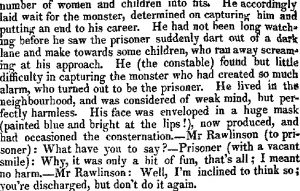
Jack turns up at the coast Rose Hill in Sussex The Times April 14 as a bear? The Times, Apr 14, 1838; pg. 7; Issue 16703; col D
“Spring Heeled Jack” has, it seems, found his way to the Sussex coast. On Friday evening, between 9 and 10 o’clock, he appeared, as we are informed, to a gardener near Rose-Hill “in the shape of a bear or some other four- footed animal” and having first attracted attention by a growl, then mounted the garden wall, covered as it was with broken glass, and ran along it upon all-fours to the great terror and consternation of the gardener who began to think it time to escape. He was accordingly about to leave the garden, when Spring Heeled Jack leaped from the wall, and chased him for some time; the dog was called, but slunk away, apparently as much terrified as his master. Having amused himself for some time with the trembling gardener, Spring-Heeled Jack scaled the wall, and made his exit. The fellow may probably amuse himself in this way once to often.
Then spread as far as Whiby were there was an incident with claws and a similar disguise.
The Leeds Mercury May 19
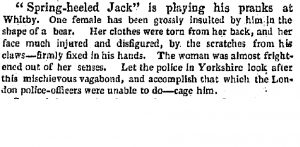
 In fact it spread to all over the county
In fact it spread to all over the county
Bristol Mercury June 2nd


1840
Several references to a racehorse named Spring Heeled Jack this year..
The Bristol Mercury February 13th how ever has a report of an attack involving the cutting a girl’s hair, in Bristol.
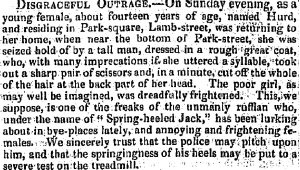

The Examiner April 11th reports another attack in London this time
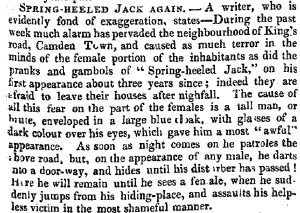

The Era the same day gives the story in more detail
ANOTHER SPRING-HEELED JACK- During the past week much alarm has prevaded the neighbourhood Kings Road Camden-town and caused as much terror in the minds of the female portion of the inhabitants are did the pranks and gambles of “Spring – heeled Jack,” on this first appearance about three years since; indeed, they are afraid to leave their houses after night fall. The cause of this fear on the part of the females is a tall man, or brute, enveloped in a large blue cloak, with glasses of dark colour over his eyes, which give him a most awful appearance. As soon as night comes he patrols the above road, on the appearance of any male, he darts to a doorway and hides until his disturber has passed. Here he will remain to he sees a female, when he suddenly he jumps from his hiding place, and assaults his hapless victim in the most shameful and indelicate manner. The spot generally selected by this vagabond for this assaults is College-grove a dark and badly paved turning, leaving from the above road to Camden High-street. This turning, in parts, is very narrow, and without a light all the way down, although the inhabitants are heavily taxed by the paving commissioners for that commodity. The way in which the females are frightened and assaulted in this place is as follows:- The miscreants jumps from his hiding place, and stretching out his arms under his cloak, makes that article of clothing have the appearance of a giant pair of black wings, which completely blocks up the thoroughfare. He then envelopes the frightened female in the folds of his coat and commits the most disgusting assaults on her. A few evenings back a lady, proceeding to her residence in Kentish Town, was met by the fellow, a few paces from St Pancras workhouse, who commenced taking the most indecent liberties with her. She made great resistance, and disengaging herself from her assailants grasp, retraced her steps and entered the Elephant and Castle public-house in the most agitated state, and after detailing the brutal way she have been treated, one of the inmates proffered his service to see her home, which was gladly accepted. A sharp lookout was kept by the man, but no traces of the miscreant could be seen. Since the above a young girl named Cope, residing in College-grove, has been so maltreated and frightened by the same fellow that she is now in a very bad state of health. Information of the above and several other outrages on females in the above locality have be given to the police, who have their eye on the delinquent: and he has not only to try and avoid their vigilance, but that of the husbands of several females he has assaulted, who will take the law into their own hands, and cool his brutal propensities by ducking him in the canal, which is very near the spot.

The Bristol Mercury August 7th Girl in Bristol attack turns to crime.
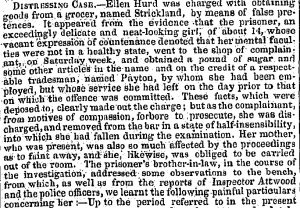
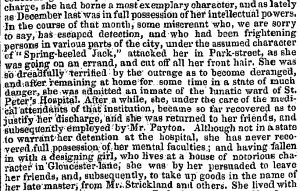
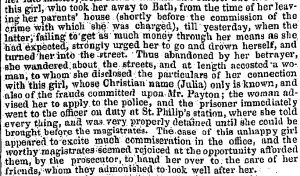
Freemans Journal & Daily Commercial Advertiser October 26th. Story of Jack playing with fire.

1845
The next mention was in 1845 Local Man as Spring Heeled Jack.
Lloyds Weekly London Newspaper February 9th
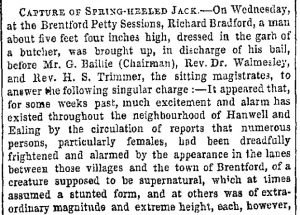
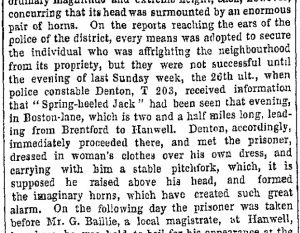
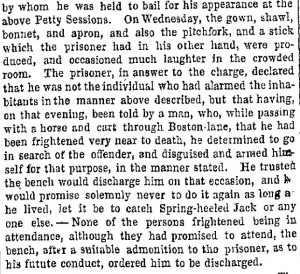
1847
During 1847 the known case of Captain Finch Case was the main news.
1849
Only small story of new incidents, Manchester Times May 18

1853
Local villain with the nick name of spring heeled jack
1862
Trewmans Exeter Flying Post May 14th
Mention of spring heeled jack during political speech
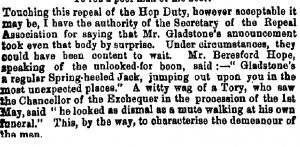
1863
During this year Spring Heeled Jack play running, and a Horse called Spring Heeled Jack racing.
An article on the sources of human hair for wigs mentions earlier attacks were hair was taken
Leeds Mercury Sept 26
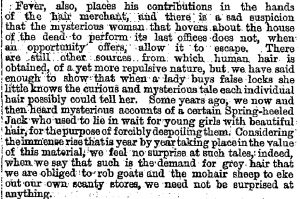
1868
The first mention of the Marquis of Waterford as possibly Spring Heeled Jack
(after his death)
Manchester Times August 1st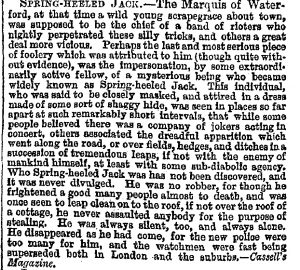
A second play comes out, advertised many times. Also criticism of Penny Dreadfuls including SHJ undermining morals in young boys, and that they should read better stories.
1872
Jack moves to Scotland.
Glasgow Herald Feb 5th
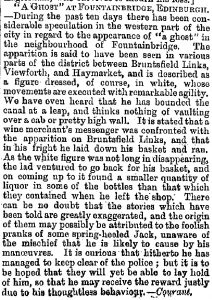
Glasgow Herald 15 Feb
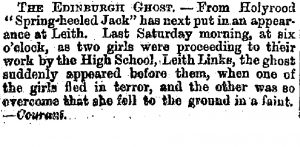
There is a mention in Music Hall Report and a Hare named after SHJ in a hare hunt.
1877
This is a very important year
The Illustrated Police News Nov. 3rd 1877 Illustration of Jack on Newport Arch.
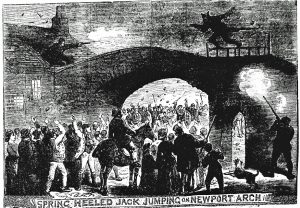

This is the year of the Aldershot incidents.
Surrey and Hants News & Guildford Times March 17th 1877, section Aldershot Gazette
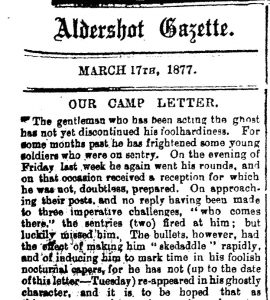

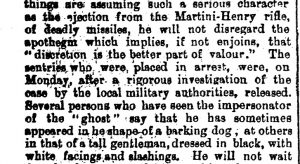
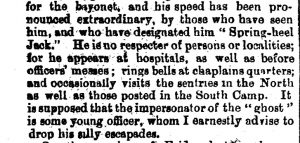
Surrey and Hants News & Guildford Times March 24th 1877, section Aldershot Gazette,
Our Camp Letter
It was rumored during the early part of the week that “Springheel Jack” or the gentleman who has been impersonating a ghost for some time, had been captured by one of the 3rd Battalion 60th Rifles. On making inquiries at the North Camp on Tuesday, I learnt that the report was groundless: but that it originated from a capture made by an old soldier (Private Harvey, 1st battalion 19th Regiment), who was on sentry near the fire screens, a few nights previously. His predecessor on the post was somewhat frightened b by what seemed to him an unearthly noise, and the rattling of the screens. In reply to Harvey’s challenge a drunken man replied “Spring Heeled Jack.” He ineffectually tried to run away. He turned out to be one of the Royal Canadian Regiment, who was doing a little amateur ghost rehearsal on his own account; and
Notwithstanding that he was fortified with a sufficient spirits to represent a ghostly character, he did it so badly and so unprofitably that he was made to pay the sum of 7s 6d., in addition to confinement in cells for 96 hours. This sentence carries with it hair cropping.
The veritable “Springheel Jack” has not shown himself since the night he was fired at by some sentries; and it is to be hoped that he will not repeat his very silly capers; for he has already occasioned a deal of additional duty on men who have not deserved it. I may add that it would be an unsoldierly and unwise act for a soldier to expend any of his ammunition on the foolish impersonator of a mythical ghost.
1878
The story now moves to Colchester
Reynolds Newspaper Nov 10th under Scraps from Comic Journals


Jack captured
Ispwich Journal Dec 21st
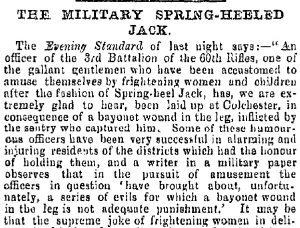
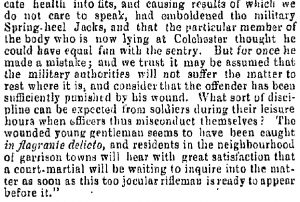
Another report on the capture from Lloyds Weekly Newspaper Dec 29, this report also appeared in Surrey and Hants News & Guildford Times 14th December 1878, section Aldershot Gazette Our Camp Letter, Leeds Mercury Dec 27th
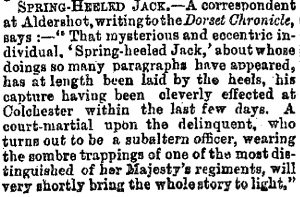
Judge Advocate General’s Office: general courts martial charge sheets, confirmed at home.1977-1880,currently in the National Archives, contains no mention of this General Court Martial.
1880
Advert for play Spring Heeled Jack Terror of London (with book reference)
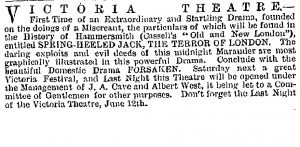
1881
Article in The Newcastle Courant May 13th mentions Jack in London

1884
Ghost in Richmond from The Northern Echo August 1st
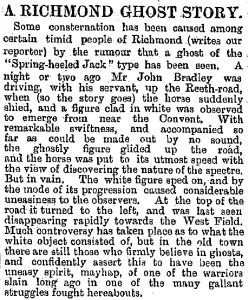

1885
The Bristol Mercury Jan 24th
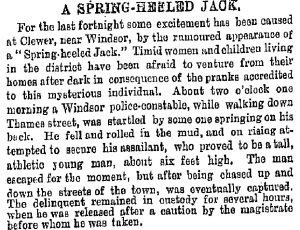
The Ipswich Journal March 14th
mentions Grove Lane Ipswich once the haunt of a Spring heeled Jack
Birmingham Daily Post January 12th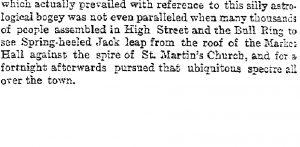
1890
Many mentions and criticisms of Spring Heeled Jack in cheap literature. Plus a jumping show with its own Spring Heeled Jack
1891
Report of an incident in Guernsey
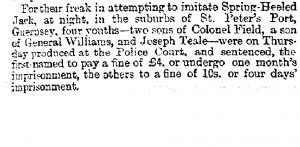
Liverpool Mercury Oct 31st. Political slip of the tongue
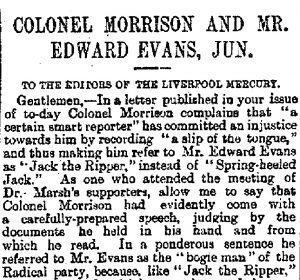
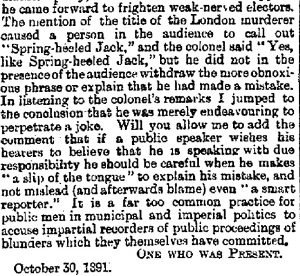
The Northern Echo December 7th
Another criminal calling himself Spring Heeled Jack
1897
Telling the story of Jack hero robber?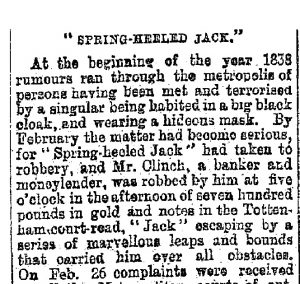
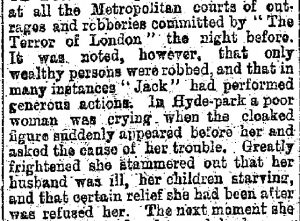
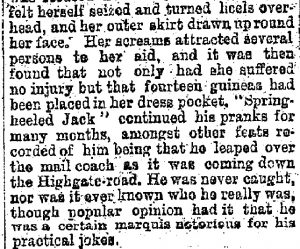
I have done research in Richmond’s Library covering the site of his first alleged attacks Barnes Common. The only thing they had was an old resident who thought he was a creature covered in lights.
To the end of the 19th Century, his name turns up everywhere. However during the first three decades of the 20th Century only twice.
Recently however the story as resurfaced in several books. There seems to be screenplays in circulation and the start of a cartoon. So spring heeled jack who was mostly forgotten in the twentieth century, but just lurking in the edge of the eye, may be a household name again.